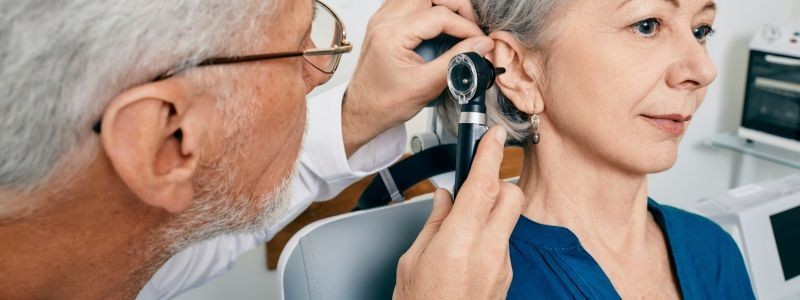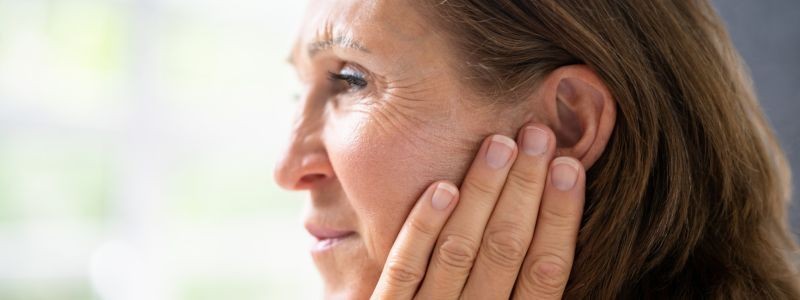Free home visits
with a local audiologist

Head of Online Medical Content

Audiology Expert at Hearing Aid UK

Overview | What is an ear infection? | Ear infection symptoms and causes | Inner ear and outer ear infections | Hearing aids and ear infections | Preventing ear infections | Managing ear infections | Conclusion
Ear infections, also known as otitis, are a common illness that affects many worldwide and are often caused by bacteria or viruses. It typically results in pain, fluid buildup, and sometimes hearing loss. Common in children, symptoms include ear pain, fever, and irritability. Treatment for ear infections usually involves antibiotics or pain relievers.
Here, we briefly talk about the various forms of ear infections, their connection to hearing aids, symptoms, causes, prevention strategies, and how to manage them effectively.
An ear infection is an inflammation of the ear. They often occur when bacteria or a virus infects the space behind the eardrum, causing irritation and pain. For those with hearing loss who wear hearing aids, the risk of developing ear infections may increase.
Though wearing hearing devices does not directly cause ear infections, moisture build-up, and improper cleaning of devices can. This is due to bacteria living and growing on the hearing aids.
Ear infections are especially common among children, but, in reality, can affect those of any age. The symptoms often present themselves suddenly and can last up to seven days once a treatment, such as antibiotics, has been prescribed.
It is important to seek treatment as soon as symptoms develop. If left untreated, the infection could spread. In severe (although rare) cases, this can spread to the bone and cause abscesses, permanent damage to the ear, and hearing loss through the narrowing of the ear canal.
This is a common type of ear infection, known as Otitis Media. It affects the air-filled space behind the eardrum housing the tiny vibrating bones called ossicles. This infection occurs when fluid becomes trapped behind the eardrum, often as a result of colds, flu, or allergies.
Upper respiratory issues, such as sinus or throat infections, can also contribute to the development of middle ear infections.
Eustachian tubes connect the middle ear to the back of the throat and the nasal passages, helping to regulate air pressure in the middle ear. Middle ear infections can cause these tubes to swell and stop natural drainage. The trapped fluid in the tubes can accumulate in the middle ear, leading to infection of the middle ear.
The typical signs to look out for include ear pain, difficulty hearing, pressure in the ear, discharge from the ear, and sometimes fever.
An inner ear infection, also known as labyrinthitis, occurs when the labyrinth deep inside the ear becomes inflamed. This could also be caused by a virus, bacteria, congestion after a cold, or when a middle ear infection spreads.
This inflammation can interfere with the transmission of sensory information from the inner ear to the brain. It is this interruption that may lead to symptoms associated with labyrinthitis and also worsen the effects of hearing loss.
Outer ear infection, also known as Otitis Externa or Swimmer's Ear, is an infection that extends from the ear canal entrance to the eardrum. It develops when water remains in the ear after activities like swimming or bathing, creating an ideal environment for bacterial growth.
Bacterial infections in the outer ear can also occur if the skin is scratched or irritated, highlighting the importance of not inserting objects into the ear.
Typical symptoms of an outer ear infection include ear pain, tenderness, redness, and swelling. Such infections can cause discomfort and swelling in the ear canal, which can interfere with the fit and comfort of hearing aids.
Outer ear infections may also affect hearing quality, making the use of certain hearing aids uncomfortable. These symptoms can persist for several days or even weeks.

Hearing aids, essential for those with hearing loss, can’t directly cause ear infections but can contribute to them if not properly maintained. When hearing aids are not inserted in the ear correctly, they might leave your ears irritated and cause pain.
If you are experiencing pain with new hearing aids, it is important to remember that it does take time to adjust to them. This is known as hearing aid newness. For tips on how to adapt to new hearing aids, please read our guide here.
Several factors can contribute to the development of ear infections, including:
Prevention is key to reducing the risk of ear infections, especially for those who rely on hearing aids. Here are some effective prevention strategies for hearing aid wearers:
Even if you take all preventive measures, those using hearing aids may still experience ear infections. Audiologists recommend not to wear your hearing aids when suffering from an ear infection.
This is because swelling and sensitivity in the ears can intensify the symptoms and cause further discomfort when wearing the devices. Hearing aids can obstruct proper ventilation, which is helpful for the ear's recovery.
There may be discharge from the ears which hearing aids can cause, it then builds up and can cause excessive earwax. This is because your body produces more of it in an attempt to naturally clear the infection.
Ideally, don’t use eardrops at the same time as wearing hearing aids (unless instructed otherwise by your audiologist or health care practitioner). The hearing aids can cause the moisture to stay in the ear longer than advised. This can promote the growth of bacteria in the ear, a known contributor to ear infections.

Ear infections can pose challenges for people relying on hearing aids, but with proper understanding, preventive measures, and timely management, their impact can be minimised.
By being consistent with good ear hygiene, regular maintenance of hearing aids, and seeking prompt medical attention, when needed, you can enjoy improved hearing health.
Incorporating these ear health habits not only reduces the risk of ear infections but also enhances the effectiveness and longevity of your hearing aids. By understanding the connection between hearing aids and ear infections, you can take proactive steps to safeguard your future hearing health.
You can also download the NHS ear infections white paper by clicking on the green button further down the page.
Are you suffering with an ear infection?
The first point of call for an ear infection is to contact your local GP, so they can diagnose the infection, the type, and recommend the appropriate treatment.
However, if you are looking for support with your hearing healthcare, whether in clinic or in the comfort of your own home, as we have nationwide coverage, we will have an audiologist near you.
 I have difficulty hearing in noisy places
I have difficulty hearing in noisy places  High-Pitched Sounds Like Birdsong Are Fading. Do I Have Hearing Loss?
High-Pitched Sounds Like Birdsong Are Fading. Do I Have Hearing Loss?  Asking people to repeat themselves frequently. Do I have hearing loss?
Asking people to repeat themselves frequently. Do I have hearing loss? Do not spend hundreds of pounds without getting a second opinion from us.
 Not only are the prices great, but the service is fantastic! Many thanks to your team.
Not only are the prices great, but the service is fantastic! Many thanks to your team.Do not put anything inside your ear to remove earwax, such as cotton buds. Avoid letting water or shampoo get into your ear. Refrain from using decongestants or antihistamines, as there is no evidence they help with ear infections.
Do not put anything inside your ear to remove earwax, such as cotton buds. Avoid letting water or shampoo get into your ear. Refrain from using decongestants or antihistamines, as there is no evidence they help with ear infections.
Cleaning your hearing aids with a cloth isn't enough to eliminate all the germs and bacteria. Alcohol pads can damage the surface, so it's best to use non-alcohol-based disinfectant wipes or spray applied with a clean cloth. Ask your audiologist to recommend their preferred brand.
When we refer to a product as 'Latest Launch', we mean it is the latest to be released on the market.
When we refer to a product as 'New', we mean that the product is the newest hearing aid model on the market.
When we refer to a product as 'Superseded', we mean that there is a newer range available which replaces and improves on this product.
When we refer to a product as an 'Older Model', we mean that it is has been superseded by at least two more recent hearing aid ranges.